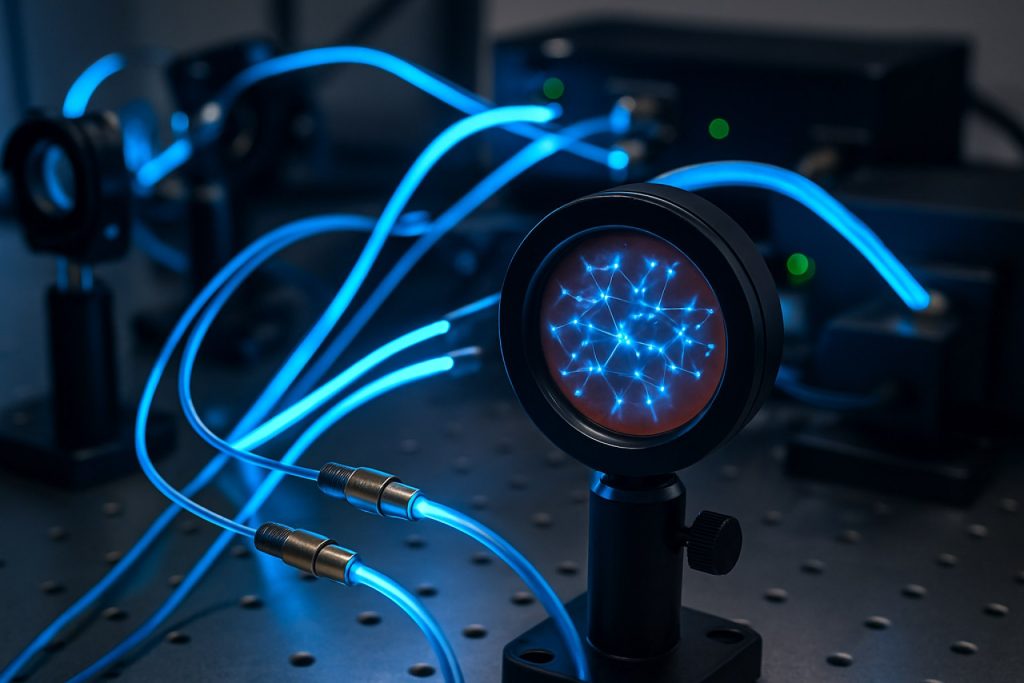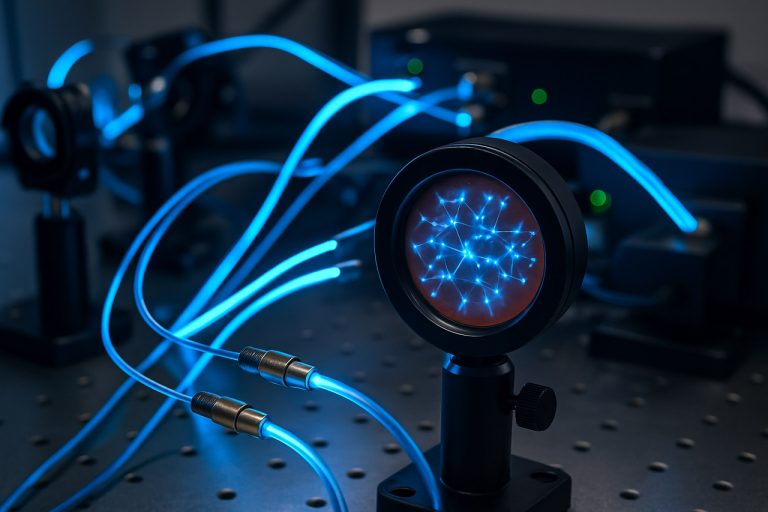
Quantum Sensor Networks Explained: Unlocking Unprecedented Precision and Connectivity in the Digital Age. Discover How This Breakthrough Technology Is Set to Transform Science, Security, and Industry.
- Introduction to Quantum Sensor Networks
- How Quantum Sensors Work: Principles and Technologies
- Key Advantages Over Classical Sensor Networks
- Breakthrough Applications: From Healthcare to National Security
- Challenges and Limitations Facing Quantum Sensor Networks
- Recent Advances and Notable Research Initiatives
- Future Outlook: Scaling, Integration, and Global Impact
- Sources & References
Introduction to Quantum Sensor Networks
Quantum sensor networks represent a transformative approach to precision measurement and information gathering, leveraging the principles of quantum mechanics to surpass the capabilities of classical sensor systems. At their core, these networks consist of spatially distributed quantum sensors—such as atomic clocks, magnetometers, or interferometers—interconnected via quantum communication channels. By exploiting quantum phenomena like entanglement and superposition, quantum sensor networks can achieve enhanced sensitivity, spatial resolution, and robustness against noise, enabling new frontiers in scientific discovery and technological innovation.
The integration of quantum sensors into networked architectures allows for the collective measurement of physical quantities, such as time, magnetic fields, or gravitational waves, with unprecedented accuracy. For example, entangled sensor arrays can outperform classical counterparts in detecting weak signals or subtle environmental changes, which is crucial for applications ranging from fundamental physics experiments to navigation, geophysics, and medical imaging. Furthermore, quantum networking protocols enable secure and efficient sharing of measurement data, paving the way for distributed quantum sensing and real-time collaborative analysis across vast distances.
Recent advances in quantum technologies have accelerated the development of practical quantum sensor networks, with research initiatives and pilot projects emerging worldwide. These efforts are supported by major organizations and government agencies, including the National Institute of Standards and Technology and the European Quantum Communication Infrastructure, which are investing in the foundational science and engineering required to realize scalable, reliable quantum sensor networks. As the field matures, quantum sensor networks are poised to become a cornerstone of next-generation measurement science and quantum-enabled technologies.
How Quantum Sensors Work: Principles and Technologies
Quantum sensor networks leverage the unique properties of quantum mechanics—such as superposition, entanglement, and quantum coherence—to achieve measurement sensitivities and spatial resolutions beyond the reach of classical sensor systems. At the heart of these networks are quantum sensors, which exploit quantum states of matter (e.g., atoms, ions, photons, or solid-state defects) to detect minute changes in physical quantities like magnetic and electric fields, time, acceleration, or temperature. The fundamental principle enabling their enhanced performance is the ability to prepare and manipulate quantum states that are highly sensitive to environmental perturbations, while also being able to read out these states with minimal disturbance.
In a quantum sensor network, multiple quantum sensors are distributed across different locations and interconnected via classical or quantum communication channels. Entanglement—a uniquely quantum correlation between particles—can be shared among sensors, allowing the network to perform joint measurements with precision scaling that surpasses the standard quantum limit. For example, entangled atomic clocks in a network can synchronize timekeeping with unprecedented accuracy, while distributed magnetometers can map magnetic fields with enhanced spatial resolution. These capabilities are underpinned by technologies such as cold atom traps, nitrogen-vacancy centers in diamond, superconducting circuits, and photonic systems, each offering distinct advantages for specific sensing tasks.
Recent advances in quantum networking protocols, error correction, and quantum memory are further enabling robust and scalable quantum sensor networks. These developments are paving the way for transformative applications in navigation, geophysics, medical imaging, and fundamental physics research, as highlighted by organizations like the National Institute of Standards and Technology and the National Quantum Initiative.
Key Advantages Over Classical Sensor Networks
Quantum sensor networks (QSNs) offer several key advantages over their classical counterparts, primarily due to the exploitation of quantum phenomena such as entanglement and superposition. One of the most significant benefits is the potential for enhanced sensitivity and precision in measurements. By leveraging entangled states, QSNs can surpass the standard quantum limit, achieving measurement accuracies that scale with the Heisenberg limit, which is fundamentally unattainable by classical means. This improvement is particularly valuable in applications such as gravitational wave detection, magnetic field mapping, and time synchronization Nature Physics.
Another advantage is the ability to perform distributed sensing with correlated quantum states across spatially separated nodes. This enables QSNs to detect weak signals or subtle changes in the environment with higher fidelity and lower noise, even over large distances. Such capabilities are crucial for tasks like environmental monitoring, navigation, and secure communications National Institute of Standards and Technology (NIST).
Furthermore, QSNs can offer intrinsic security benefits. Quantum correlations can be used to detect eavesdropping or tampering, providing a level of trust and data integrity that classical networks cannot match. This is particularly relevant for critical infrastructure and defense applications Defense Advanced Research Projects Agency (DARPA).
In summary, quantum sensor networks promise transformative improvements in sensitivity, scalability, and security, positioning them as a disruptive technology for next-generation sensing and measurement systems.
Breakthrough Applications: From Healthcare to National Security
Quantum sensor networks are poised to revolutionize a wide array of fields by leveraging entanglement and quantum correlations to achieve unprecedented sensitivity and precision. In healthcare, these networks can enable non-invasive imaging and diagnostics at the molecular or even atomic scale, potentially allowing for early detection of diseases such as cancer or neurodegenerative disorders. For example, quantum-enhanced magnetic resonance imaging (MRI) could provide higher resolution images with lower doses of radiation, improving patient outcomes and safety. Research initiatives by organizations like the National Institutes of Health are already exploring these possibilities.
In the realm of national security, quantum sensor networks offer transformative capabilities in surveillance, navigation, and threat detection. Quantum gravimeters and magnetometers can detect minute changes in gravitational or magnetic fields, enabling the identification of underground structures or submarines with far greater accuracy than classical sensors. The Defense Advanced Research Projects Agency (DARPA) is actively investing in quantum sensing technologies for applications such as GPS-independent navigation and enhanced situational awareness.
Beyond these sectors, quantum sensor networks have the potential to impact environmental monitoring, industrial automation, and fundamental science. Their ability to operate in distributed configurations allows for real-time, large-scale data collection and analysis, opening new frontiers in precision measurement. As research and development accelerate, the integration of quantum sensor networks into critical infrastructure is expected to drive significant advances in both public health and national security.
Challenges and Limitations Facing Quantum Sensor Networks
Quantum sensor networks (QSNs) promise transformative advances in precision measurement, navigation, and fundamental science. However, their practical deployment faces significant challenges and limitations. One of the foremost issues is decoherence, where quantum states are disrupted by environmental noise, leading to loss of information and reduced sensitivity. Maintaining entanglement and coherence over large distances or extended periods remains a formidable technical hurdle, especially outside laboratory conditions Nature Physics.
Another major challenge is the scalability of QSNs. Integrating a large number of quantum sensors into a coherent network requires precise synchronization and control, which is complicated by the fragility of quantum states. The need for robust quantum communication links, such as quantum repeaters, adds further complexity and cost National Institute of Standards and Technology (NIST).
Resource requirements also pose limitations. Quantum sensors often demand cryogenic temperatures, ultra-high vacuum, or specialized materials, making them less practical for widespread or field deployment. Additionally, the integration with classical infrastructure—including data processing, error correction, and network management—remains an open problem, as classical and quantum systems operate under fundamentally different principles Nature.
Finally, standardization and interoperability are lacking, with few established protocols for quantum network operation. This hinders collaboration and slows the transition from experimental setups to real-world applications. Overcoming these challenges will require advances in quantum engineering, materials science, and network theory, as well as coordinated international efforts.
Recent Advances and Notable Research Initiatives
Recent years have witnessed significant progress in the field of quantum sensor networks, driven by advances in quantum communication, entanglement distribution, and precision measurement. One notable breakthrough is the demonstration of entanglement-enhanced sensing across distributed sensor nodes, which has been shown to surpass classical limits in both sensitivity and spatial resolution. For example, researchers at Massachusetts Institute of Technology have developed protocols for entangling atomic ensembles over kilometer-scale distances, enabling highly sensitive magnetic field measurements that could revolutionize geophysical exploration and medical imaging.
International collaborations have also played a pivotal role. The Quantum Flagship initiative, funded by the European Union, supports several projects focused on integrating quantum sensors into networked architectures for applications ranging from navigation to environmental monitoring. In the United States, the Defense Advanced Research Projects Agency (DARPA) has launched the Quantum Apertures program, aiming to develop distributed quantum sensor arrays for enhanced detection capabilities in defense and security contexts.
Additionally, the National Institute of Standards and Technology (NIST) has pioneered research into quantum network protocols that enable secure and efficient sharing of quantum information between sensor nodes. These efforts are complemented by advances in quantum memory and error correction, which are critical for maintaining coherence and reliability in large-scale sensor networks. Collectively, these initiatives are rapidly advancing the practical deployment of quantum sensor networks, with pilot projects already underway in urban infrastructure monitoring and fundamental physics experiments.
Future Outlook: Scaling, Integration, and Global Impact
The future of quantum sensor networks (QSNs) is poised for transformative advances, with scaling, integration, and global impact at the forefront of ongoing research and development. As quantum technologies mature, the challenge of scaling QSNs from laboratory prototypes to large-scale, robust networks is being addressed through innovations in quantum repeaters, error correction, and entanglement distribution. These advances are crucial for extending the range and reliability of quantum-enhanced sensing across vast distances, enabling applications such as continent-spanning navigation systems and global environmental monitoring.
Integration with existing classical infrastructure is another key focus. Hybrid architectures that combine quantum sensors with classical communication and data processing systems are being developed to facilitate seamless deployment in real-world environments. This integration is expected to accelerate the adoption of QSNs in sectors such as healthcare, defense, and smart cities, where enhanced sensitivity and security are paramount. Efforts by organizations like the National Institute of Standards and Technology and the European Quantum Flagship are driving standardization and interoperability, which are essential for widespread implementation.
On a global scale, the impact of QSNs could be profound. By enabling ultra-precise measurements of time, gravity, and electromagnetic fields, QSNs have the potential to revolutionize fields ranging from geophysics to climate science and secure communications. International collaborations and investments are accelerating progress, with initiatives such as the U.S. National Quantum Initiative and the UK Quantum Communications Hub supporting research, infrastructure, and workforce development. As these networks scale and integrate, their global impact is expected to reshape technology, industry, and society in the coming decades.
Sources & References
- National Institute of Standards and Technology
- Nature Physics
- Defense Advanced Research Projects Agency (DARPA)
- Massachusetts Institute of Technology
- UK Quantum Communications Hub



